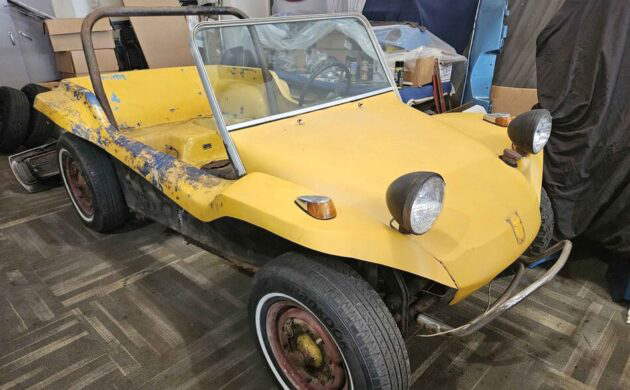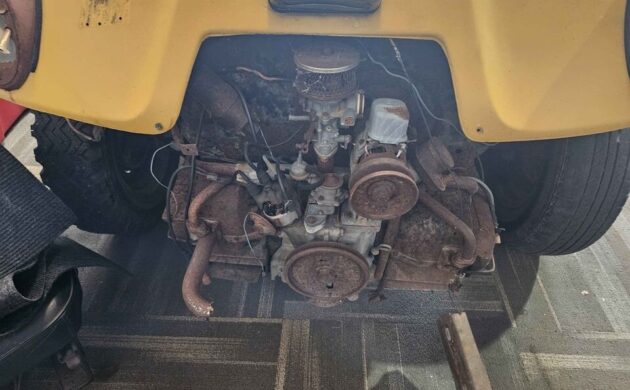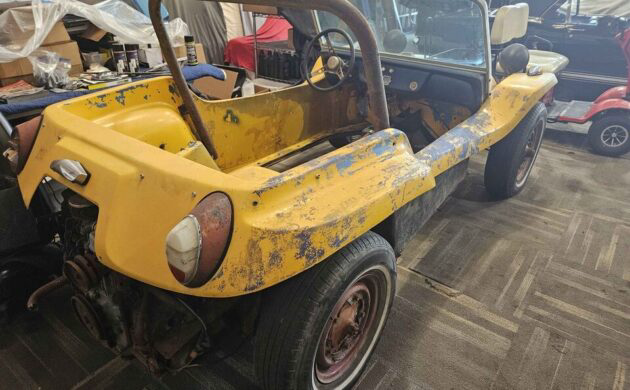We’ve told the story of Bruce Meyers and the Manx several times in the pages of Barn Finds, but it’s worth mentioning again that while the Meyers Manx wasn’t the first dune buggy, it was certainly one of the most famous renditions of that playful genre. Bruce Meyers had the benefit of experience with fiberglass, an education as an artist, and sand between his toes; the design he created perfectly expressed the freewheeling spirit of SoCal in the 1960s. The sassy fiberglass Manx body is barely settled on its chassis, with a smile at the front end and a stubby rump at the rear. Only about 6,000 Manx kits were built in the 1960s, but more than 250,000 copies were made by a range of companies. The competition sent Bruce Meyers’ company into bankruptcy when he was unable to enforce a patent. Here on facebook Marketplace is a real Manx, titled as a 1968, with an asking price of $15,000. The price includes a variety of parts including an extra rolling chassis and a Porsche 914 1.7 liter flat-four engine. Bring your trailer to Port Richey, Florida to pick her up. Sharp-eyed Patrick S. found this Manx for us – thanks, Patrick!
The Manx came as a kit (except for a very few examples built at the factory) designed for a Volkswagen pan, but engines derived from the Corvair, various VWs, Porsche, and even a radial aircraft motor. I think this seller had a notion to replace this one’s VW mill with the 914 flat-four that comes with the sale. In any case, depending on what motor the Manx receives, top speed can range from about 60 to over 100 mph. The Manx inspired off-road racing in Mexico, and the make’s speed records at Baja, in slalom events, and in multiple hill climbs are legion.
The interior reveals a need for floor pans, but not to fret: as noted, the seller is including an extra rolling pan with four-wheel disc brakes, a new front end, and Porsche control arms. The Manx was built for a shortened VW chassis, so presumably, the buyer will be responsible for the tailoring job.
This Manx comes with a certificate testifying to its originality as well as its VIN plate. With the wide disparity between genuine restored Manx prices and everyday copies, provenance is important. Finished Manxes routinely sell for $30k to $40k – sometimes even more – while copies struggle to sell in the low teens. Rumor has it that certificates have been faked. I’m sure that applies to VIN plates too, but at least this plate appears original. Verifying a Manx is the topic of numerous YouTube videos, or you can go this route. For a real-deal project Manx and the extras that come with it, $15k seems like a reasonable price; what do you think?









Yes very cool and rough. Posted 5 weeks ago.
Yep, posted weeks ago and no reduction in price. Body worth at most $5K. Good luck getting anywhere near asking price.
Can’t believe the going price for these. I remember back in the 70s, seems like a lot of kids had these on the streets. Seemed like fun, but not real practical. Of course, buggies back then were cheap as dirt. An old Bug frame and engine was pretty much a give away item, easy to work on in your parents garage. Good summer fun, back when young people didn’t spend hours turning into phone loving zombies and got a little fresh air once in a while. Things were better back then, in many many ways.
I owned a MANX in the early 70s. Bought it from my brother for $500. Yellow fiberglass just like this one. That thing was a blast to drive. Even I was able to pick up chics in the MANX. I carried duck tape and bailing wire and I could fix anything that broke on it. Now this one is missing the hood emblem and the MANX emblem on the rear by the taillight. The outline is there so I’m sure this is a MEYERS MANX. Someone will have fun fixin this up and drivin it.
When I built mine, I was lazy (and seventeen) and didn’t relocate the fuel filler neck to the center of the tank: This one was built the same way. When I would drive the car with the tank even half full, fuel would splash out of the gas cap and splash onto the hood and windshield. Instinctively, I’d turn on the windshielf wipers . This was definitely not a car to smoke cigarettes in!
The buggy met its demise when one of the brake line rusted through and my leg got soaked with brake fluid when I stepped on the pedal… Just before the pedal hit the floor.(the brake line runs INSIDE the cockpit, on the drivers side of the tunnel) I managed to stop using the emergency brake and not hit anything.
My friend in the passenger seat had given me a dollar for gas just before we set out on our ride. He practicality soiled his pants! The first words out of my mouth were ” Best ride you’ll ever get for a dollar!
I actually drove it home (3 miles +) with no brakes. ( my friend chose to walk instead) He later became a Lawyer… I’m lucky that he didn’t sue me for “trauma” when he passed the bar.
This one looks pretty rough for the price. The early bodies are desirable if they are still in OG Gelcoat, but this one cannot be saved and will have to be painted. The included second pan is later and has IRS rather than swing axles. IRS suspension won’t work with the 1st Series Manx unless you cut out the wells moulded into the rear seat area. The 2nd Series Manx was developed without the wells to gain the needed clearance to address this issue.
WAY too expensive for a project Manx in this condition.
Keep the 914-4 and sell it separate.
Max of 4K for this nearly a full basket case.
Looks like the seller is thinking that if someone will pay him his asking price, he will let his project go.
If not, he’ll probably just continue on and end up with something very nice.